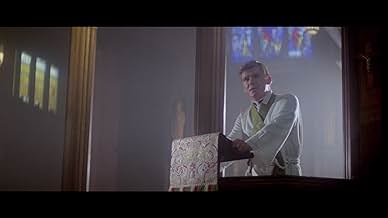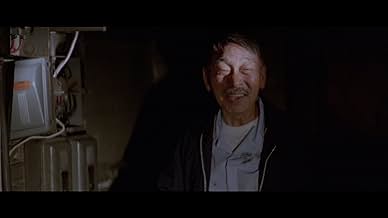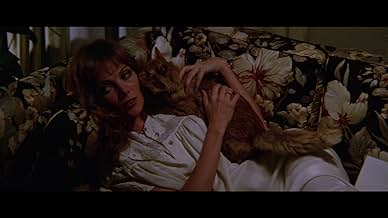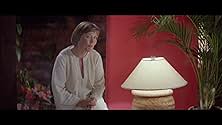IMDb-BEWERTUNG
5,5/10
2810
IHRE BEWERTUNG
Eine Frau wird in den Tagen vor ihrem Geburtstag von ihrer mörderischen, psychopathischen Zwillingsschwester verfolgt.Eine Frau wird in den Tagen vor ihrem Geburtstag von ihrer mörderischen, psychopathischen Zwillingsschwester verfolgt.Eine Frau wird in den Tagen vor ihrem Geburtstag von ihrer mörderischen, psychopathischen Zwillingsschwester verfolgt.
Patricia Mickey
- Julia Sullivan
- (as Trish Everly)
Morgan Most
- Helen
- (as Morgan Hart)
Empfohlene Bewertungen
"Madhouse," also released under the titles "And When She Was Bad" and "There Was a Little Girl," focuses on Julia, a teacher in Savannah, Georgia whose twin sister, Mary, has spent most of her life in a psychiatric institution. After an overdue visit to see her, Julia becomes increasingly paranoid about her sister's ominous warning that she will take revenge on her, and as their mutual birthday approaches, people in Julia's life start dying.
Co-written and directed by Italian filmmaker Ovidio G. Assonitis (who several years prior directed the fever-dream "Exorcist" ripoff "Beyond the Door"), "Madhouse" is a halfway decent slasher film that draws on a confluence of contemporaries, but doesn't quite manage to live up to what it sets out to do. The film has been credited by genre fans for its atmosphere and photography, and that is most definitely where I feel the film excels as well. The house it's set in is wildly eerie and the Georgia setting lends an additional layer of Southern Gothic atmosphere that is at times intoxicating.
At times the film feels like a straightforward slasher; at others, it seems like it's edging into the territory of the supernatural, and this lack of transparency keeps the audience on their toes for the first half. The film begins to lose this balancing act though in the last thirty minutes with a premature slipshod reveal and a conclusion that feels uninspired and lazily unfurled. It doesn't necessarily go where you expect it to—I'll give it that— but it's less about the nature of the revelation and more about how it's broached in the narrative. The film was notoriously banned in the UK during the "video nasty" era, and it does boast some considerable gore, though I did feel the bulk of the killings relied a bit too much on the canine dispatch (which itself seems to be a riff on "The Omen" and "Suspiria"). The cast is mostly made up of unknowns, but the performances are decent for a film of this type.
Overall, I found "Madhouse" to be a bit underwhelming, mainly because it sets itself up for greatness, and then handles its conclusion in a way that feels lazy and uninspired given all that precedes it. As sluggish as the last act is, I do have to praise the film for its curation of atmosphere and the moody cinematography. There are some truly unnerving scenes in the house that are memorable, and the film does manage to establish a sense of foreboding before it nearly undoes itself. 6/10.
Co-written and directed by Italian filmmaker Ovidio G. Assonitis (who several years prior directed the fever-dream "Exorcist" ripoff "Beyond the Door"), "Madhouse" is a halfway decent slasher film that draws on a confluence of contemporaries, but doesn't quite manage to live up to what it sets out to do. The film has been credited by genre fans for its atmosphere and photography, and that is most definitely where I feel the film excels as well. The house it's set in is wildly eerie and the Georgia setting lends an additional layer of Southern Gothic atmosphere that is at times intoxicating.
At times the film feels like a straightforward slasher; at others, it seems like it's edging into the territory of the supernatural, and this lack of transparency keeps the audience on their toes for the first half. The film begins to lose this balancing act though in the last thirty minutes with a premature slipshod reveal and a conclusion that feels uninspired and lazily unfurled. It doesn't necessarily go where you expect it to—I'll give it that— but it's less about the nature of the revelation and more about how it's broached in the narrative. The film was notoriously banned in the UK during the "video nasty" era, and it does boast some considerable gore, though I did feel the bulk of the killings relied a bit too much on the canine dispatch (which itself seems to be a riff on "The Omen" and "Suspiria"). The cast is mostly made up of unknowns, but the performances are decent for a film of this type.
Overall, I found "Madhouse" to be a bit underwhelming, mainly because it sets itself up for greatness, and then handles its conclusion in a way that feels lazy and uninspired given all that precedes it. As sluggish as the last act is, I do have to praise the film for its curation of atmosphere and the moody cinematography. There are some truly unnerving scenes in the house that are memorable, and the film does manage to establish a sense of foreboding before it nearly undoes itself. 6/10.
Julia, a teacher in a school for the deaf, has a hideously deformed and deranged twin sister that resides in the local loony bin. She escapes to gate-crash a surprise birthday party for Julia. Sort of like "Halloween", but not exactly. This is more like the left-handed, red-headed little step-cousin through marriage. That is to say, a much lesser breed. (Some have gone so far as to call it a ripoff of "Happy Birthday to Me", but that is unfair.)
In the world of Italian horror, the name Ovidio G. Assonitis doesn't get floated around much. I mean, did you ever see the "Jaws" ripoff "Tentacles"? The one where Shelley Winters wears the giant hat? If you have seen one of Assonitis' films, it was most likely one of these two. And even then, it was probably on accident unless you searched "Madhouse" out for being on the Video Nasties list.
Critic Jim Harper's analysis of this film is well-stated. Harper describes the film, aside from the notorious dog scene (which is not as shocking as you may think), as "not quite so interesting". He deems that the movie "can't be considered a total failure", which is a bit of a forced compliment. Really, the plot is not much to work with, and the only thing that distinguishes this film from other Italian films of the same period is the superior video quality (which looked great in 2008 and looks even better in 2017 thanks to the Arrow 2K restoration).
Harper understates the score of Riz Ortolani as "annoying". While annoying is an accurate summary, this doesn't really highlight the full extent of its inanity. What you will hear is an odd group of space sounds that would fit perfectly on an Atari game, such as "Asteroids", but has no place in a movie of this kind -- or maybe any kind. What is called "music" is little more than sound effects poorly strung together. This is a shame as Riz Ortolani was also the composer of "Mondo Cane" and "Cannibal Holocaust", among many others, so he can clearly do better.
Fans and collectors of Italian horror or slashers will take delight in watching this one. Yes, it is poorly scripted, low budget and comes with minimal plot. But, frankly, this is something that makes the slasher film enjoyable. If this is what you're looking for, give "Madhouse" (or "There Was a Little Girl", as it is sometimes called) a try. If you're looking for superior horror fare or a positive introduction to Italian horror, this is not it. Try some Fulci or Argento from this period first.
The Arrow Blu-ray features audio commentary with Justin Kerswell, author of "The Slasher Movie Book", and his friends. We have a new interview with actress Edith Ivey (who recounts the way the director had to direct through an interpreter). There is also a new 18-minute interview with cinematographer Roberto D'Ettorre Piazzoli, who may perhaps be the one who knew the director best. And, surprise, a brief interview with Ovidio Assonitis himself (and his English is actually very good). The only thing missing is a chat with the lead actress (Trish Everly), who never appeared in anything else before or since. Where is she?
In the world of Italian horror, the name Ovidio G. Assonitis doesn't get floated around much. I mean, did you ever see the "Jaws" ripoff "Tentacles"? The one where Shelley Winters wears the giant hat? If you have seen one of Assonitis' films, it was most likely one of these two. And even then, it was probably on accident unless you searched "Madhouse" out for being on the Video Nasties list.
Critic Jim Harper's analysis of this film is well-stated. Harper describes the film, aside from the notorious dog scene (which is not as shocking as you may think), as "not quite so interesting". He deems that the movie "can't be considered a total failure", which is a bit of a forced compliment. Really, the plot is not much to work with, and the only thing that distinguishes this film from other Italian films of the same period is the superior video quality (which looked great in 2008 and looks even better in 2017 thanks to the Arrow 2K restoration).
Harper understates the score of Riz Ortolani as "annoying". While annoying is an accurate summary, this doesn't really highlight the full extent of its inanity. What you will hear is an odd group of space sounds that would fit perfectly on an Atari game, such as "Asteroids", but has no place in a movie of this kind -- or maybe any kind. What is called "music" is little more than sound effects poorly strung together. This is a shame as Riz Ortolani was also the composer of "Mondo Cane" and "Cannibal Holocaust", among many others, so he can clearly do better.
Fans and collectors of Italian horror or slashers will take delight in watching this one. Yes, it is poorly scripted, low budget and comes with minimal plot. But, frankly, this is something that makes the slasher film enjoyable. If this is what you're looking for, give "Madhouse" (or "There Was a Little Girl", as it is sometimes called) a try. If you're looking for superior horror fare or a positive introduction to Italian horror, this is not it. Try some Fulci or Argento from this period first.
The Arrow Blu-ray features audio commentary with Justin Kerswell, author of "The Slasher Movie Book", and his friends. We have a new interview with actress Edith Ivey (who recounts the way the director had to direct through an interpreter). There is also a new 18-minute interview with cinematographer Roberto D'Ettorre Piazzoli, who may perhaps be the one who knew the director best. And, surprise, a brief interview with Ovidio Assonitis himself (and his English is actually very good). The only thing missing is a chat with the lead actress (Trish Everly), who never appeared in anything else before or since. Where is she?
Okay, I admit this film isn't a masterpiece by any stretch, but slasher aficionados should find it enjoyable. I certainly did and was rather surprised by all the negative reviews I'd previously read. Granted, it's slow going in places, but the murders are genuinely creepy, as well as performances by Dennis Robertson as the twisted Father James and Allison Biggers as the deformed sister, Mary. Some ample doses of blood (in the unrated version) also add to the proceedings. While the film may not appeal to erstwhile horror fans, anybody with a taste for slashers will surely appreciate this entry in the genre.
Note: Some reviewers have condemned this film for lifting a scene out of HAPPY BIRTHDAY TO ME, but the the fact of the matter is that both films were released in the same year (1981), so it's debatable as to who stole what from whom. Personally, I preferred the scene as it was staged in this film, regardless of which came first. See it for yourself and you be the judge.
Note: Some reviewers have condemned this film for lifting a scene out of HAPPY BIRTHDAY TO ME, but the the fact of the matter is that both films were released in the same year (1981), so it's debatable as to who stole what from whom. Personally, I preferred the scene as it was staged in this film, regardless of which came first. See it for yourself and you be the judge.
Madhouse stars Trish Everly as Julia Sullivan, a teacher at a school for the deaf, whose hideously disfigured and sadistic twin sister, Mary, resides in a nearby mental hospital. Four days before Trish's birthday, Mary escapes in order to arrange a special party for her unsuspecting sister...
In the United Kingdom in the 1980s, movies released on home video became the target of a hate campaign led by Britain's über-vigilant defenders of moral decency: the press, bored housewives, and Conservative politicians. As a result, a list was compiled of the films they deemed to be most offensive; these titles became known as 'Video Nasties' and were seized from shops before they had a chance to work their evil influence on an unsuspecting public.
Ovidio G. Assonitis's Madhouse was one such 'nasty'.
Featuring a bloodthirsty rottweiler, a frenzied axe attack that reduces the victim's back to a bloody pulp, and a messy canine lobotomy by electric drill, it quickly found itself added to the list of titles most likely to corrupt and deprave. It didn't matter much to the moral crusaders that the film was also a well-crafted psychological chiller that delivered plenty of atmosphere, memorable performances, and some lovely cinematography; no... this film featured a dog receiving a drill-bit between the eyes, and we can't have people watching that kind of stuff, can we?
Two decades on, and Madhouse is now available uncut on DVD; it seems that the people of the UK have since developed to a stage where they are able to handle such horror without it turning them into murderous lunatics (either that, or the authorities have actually realised they were wrong and the film was never that disturbing in the first place). Oh well, better late than never, I suppose...
Ironically, Assonitis's film is perhaps a little too slow and lacking in gore for today's casual horror viewer, but for seasoned fans of the genre, it offers plenty to enjoy: there's the mystery of the identity of a second killer (not too hard to guess, but fun nevertheless); a great OTT performance from Dennis Robertson as Father James, Trish's nursery-rhyme singing uncle; a likable heroine; a brief performance from Morgan Hart as very tasty, blonde rottweiler fodder, Helen; and a ghoulish final scene that is remarkably similar to that of a Canadian slasher, Happy Birthday To Me (who stole from whom is debatable, since both films were released in the same year).
In the United Kingdom in the 1980s, movies released on home video became the target of a hate campaign led by Britain's über-vigilant defenders of moral decency: the press, bored housewives, and Conservative politicians. As a result, a list was compiled of the films they deemed to be most offensive; these titles became known as 'Video Nasties' and were seized from shops before they had a chance to work their evil influence on an unsuspecting public.
Ovidio G. Assonitis's Madhouse was one such 'nasty'.
Featuring a bloodthirsty rottweiler, a frenzied axe attack that reduces the victim's back to a bloody pulp, and a messy canine lobotomy by electric drill, it quickly found itself added to the list of titles most likely to corrupt and deprave. It didn't matter much to the moral crusaders that the film was also a well-crafted psychological chiller that delivered plenty of atmosphere, memorable performances, and some lovely cinematography; no... this film featured a dog receiving a drill-bit between the eyes, and we can't have people watching that kind of stuff, can we?
Two decades on, and Madhouse is now available uncut on DVD; it seems that the people of the UK have since developed to a stage where they are able to handle such horror without it turning them into murderous lunatics (either that, or the authorities have actually realised they were wrong and the film was never that disturbing in the first place). Oh well, better late than never, I suppose...
Ironically, Assonitis's film is perhaps a little too slow and lacking in gore for today's casual horror viewer, but for seasoned fans of the genre, it offers plenty to enjoy: there's the mystery of the identity of a second killer (not too hard to guess, but fun nevertheless); a great OTT performance from Dennis Robertson as Father James, Trish's nursery-rhyme singing uncle; a likable heroine; a brief performance from Morgan Hart as very tasty, blonde rottweiler fodder, Helen; and a ghoulish final scene that is remarkably similar to that of a Canadian slasher, Happy Birthday To Me (who stole from whom is debatable, since both films were released in the same year).
As co-written and directed by Ovidio Assonitis ("Beyond the Door", "Tentacles"), "There Was a Little Girl" (a.k.a. "Madhouse") is a mostly tedious affair running through the standard slasher paces adequately but without any real style. For its first two thirds, it actually plays more like a drama with some horror moments than an out and out horror film. It's too bad it got labelled as a Video Nasty, as it's never really that gory, at least not until the end. The good thing is that the performances are better than expected, and things do get marginally more interesting in the final third, with a plot development that some horror fans may see coming and some may not.
Trish Everly stars as Julia, a teacher in a school for deaf children whose birthday is nearing. In the days leading up to it, her deformed, demented twin sister Mary (Allison Biggers) escapes from the hospital. It seems that Mary had dominated and terrorized the meek Julia during their childhood, and now Julia is more than a little concerned. Mary had had a spooky canine companion when the two women were young, and now there's a bloodthirsty dog adding to the weirdness.
For around an hour or so, this is just a little too dull, although Assonitis succeeds in building some atmosphere. But the story becomes more fun upon its one true big reveal. Eventually, this bears some strong resemblances to the Canadian slasher "Happy Birthday to Me", although it's hard to say whether one movie ripped off the other or not. The beautiful Everly does an okay job in the lead, the equally lovely Morgan Most is fine as her friend, and Michael MacRae is acceptable as Julias' psychiatrist / lover, but the person who steals the show is Dennis Robertson as the friendly Father James. The animal work is good; trainer Joe Camp plays the ill-fated hospital guard. However, during the finale, when the crazed dog comes through a door, a special effect is employed, and it's laughably horrible.
Overall, a decent shocker redeemed to a degree by its last act.
Five out of 10.
Trish Everly stars as Julia, a teacher in a school for deaf children whose birthday is nearing. In the days leading up to it, her deformed, demented twin sister Mary (Allison Biggers) escapes from the hospital. It seems that Mary had dominated and terrorized the meek Julia during their childhood, and now Julia is more than a little concerned. Mary had had a spooky canine companion when the two women were young, and now there's a bloodthirsty dog adding to the weirdness.
For around an hour or so, this is just a little too dull, although Assonitis succeeds in building some atmosphere. But the story becomes more fun upon its one true big reveal. Eventually, this bears some strong resemblances to the Canadian slasher "Happy Birthday to Me", although it's hard to say whether one movie ripped off the other or not. The beautiful Everly does an okay job in the lead, the equally lovely Morgan Most is fine as her friend, and Michael MacRae is acceptable as Julias' psychiatrist / lover, but the person who steals the show is Dennis Robertson as the friendly Father James. The animal work is good; trainer Joe Camp plays the ill-fated hospital guard. However, during the finale, when the crazed dog comes through a door, a special effect is employed, and it's laughably horrible.
Overall, a decent shocker redeemed to a degree by its last act.
Five out of 10.
Wusstest du schon
- WissenswertesThe entire crew had to be still and quiet during the shooting of any scenes involving the Rottweiler dogs.
- PatzerKiller stabs a woman with a knife, but only the tip of the knife is covered in blood.
- Zitate
Mary Sullivan: How would you like to run into that every morning before breakfast? Most people's nightmares end when they wake up; mine begin.
- Alternative VersionenThe 2004 UK Film 2000 release is fully uncut, although the sound quality is very poor.
- VerbindungenFeatured in Video Nasties: Moral Panic, Censorship & Videotape (2010)
Top-Auswahl
Melde dich zum Bewerten an und greife auf die Watchlist für personalisierte Empfehlungen zu.
Details
- Laufzeit1 Stunde 32 Minuten
- Sound-Mix
- Seitenverhältnis
- 2.35 : 1
Zu dieser Seite beitragen
Bearbeitung vorschlagen oder fehlenden Inhalt hinzufügen

Oberste Lücke
By what name was Party des Schreckens (1981) officially released in India in English?
Antwort





















